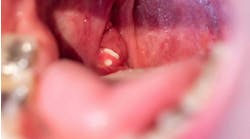‘Different strokes for different folks' is all too true when it comes to home care products. The answer is to listen to patients and figure out what they are capable of and willing to do.
by Connie L. Sidder, RDH, BS, OM
With so many choices in brushes and floss, it has become increasingly difficult for our patients to make up their minds. Also, with the popularity of powered brushes, patients can become confused even further on the proper way to brush. We frequently treat patients who could improve their home care, but lack the proper technique to do so. Yet it can be difficult, without embarrassing an adult patient, to teach him or her new tricks.
Upstairs/Downstairs with the Kids
Kids are easy to teach. While some lack the dexterity to properly brush, hopefully their parents assist them. Putting it in juvenile terms, I have come up with "inside, outside, upstairs, downstairs." This means the linguals, and facial/buccal surfaces for both the maxillary arch as well as the mandibular.
However, a key element to brushing is being able to concentrate on the brushing, so I like to tell children that the brush doesn't have a brain! They are the ones who need to direct the brush over the inside and outside surfaces to do a good job. Hopefully this will result in a longer brushing session. (It is said that the average time spent brushing is 20 seconds, as opposed to the two minutes recommended.) I try to stay away from the back-and-forth method of brushing and teach "down on the uppers, up on the lowers" so as to discourage any cross brushing. Circle brushing, although difficult for a child, is better than scrubbing. This is because bad habits are hard to break! I personally don't recommend that young children floss, due to the potential to do more harm than good, but I do tell them their parents can help if they get food stuck between their teeth.
Anteriors for Adults
According to several Internet sites, including Colgate and the ADHA, the preferred brushing for adults is placing the brush toward the gums at a 45 degree angle to the teeth, then circling. In doing so, the bristles are better able to clean in between the teeth and massage along the gumline.
But what to do when approaching the anterior teeth? The biggest problem area is the linguals of the mandibular incisors. All of the Web sites recommend the top of the brush in this area. Often toothbrushes are longer at the top to better reach these areas. However, this results in the bristles being bent away from the teeth and gumline when pressure is applied.
The hygienists who have been around as long as I have may remember a Butler toothbrush salesman named Ace Leonard. Ace was a very dapper dresser who was with Butler for many years and really knew his product. Now the Butler brush has the patented dome shape that lends itself to the recommended 45 degree angle. But what Ace showed me for cleaning the linguals of the incisors makes the most sense, and in practice has been the one tool that is most effective. Instead of using the "toe" of the brush with its longer bristles, use the "heel" of the brush, thereby shortening the length of the brush and applying the 45 degree angle. Also, the bristles bend toward the gumline and fall in between the teeth to clean better.
I have been using this method for many years with much success. Now the problem becomes how to translate this to an electric brush. The head of a Sonicare brush is similar to a manual brush, so the same principles apply. However, the Oral-B/Braun brush must be demonstrated. In trying to achieve the 45 degree angle, the outer row of bristles needs to be tipped at an angle. When the whole brushhead is used, it is unable to contour adequately to the teeth. The brushhead appears to be facing downward using this technique. But by allowing the brush to do the work, just placing the outer row of bristles at the proper angle will allow for better cleaning and patient brushing. Patients can tell immediately that this method works better; it's just getting them to use it! We do know more about brushing than our patients, and with new techniques we can help them.
As for teaching use of electric brushes, such as the Crest Spin® or Oral-B/ Braun series, "walking" the brush over the teeth as we would for polishing allows for better cleaning between the teeth. This "walking" method can be demonstrated with a finger rolling over the teeth at a speed that simulates brushing speed. It should ideally take two minutes to complete a good brushing.
We assume that our adult patients have been taught how to brush and floss, but I have found many of them floundering. This also holds true for flossing. How many times have we heard, "I have a hard time reaching the back teeth," or "I don't like to floss because it cuts off the circulation in my fingers!"
Most Internet sites that teach "how to" floss agree that a piece of floss about 18 inches long should be wound around a middle fingers so that the index fingers are free to carry the floss to the back teeth. This needs to be demonstrated for patients. Also, patients should be told that changing flossing methods will take a few tries to become proficient. As for those that don't like to floss, if one wraps the floss around the two middle fingers, circulation will not be cut off. There is no need to wrap tightly.
Let us not forget those who don't even like to put their hands in their mouths. For them, there is the Oral-B Hummingbird® or the WaterPik power flossers. These hand-held flossers also work well for under bridges.
And don't forget the "old reliable" rubber tip. Here's a true story. An octogenarian returned for his second cleaning at our office and asked me rather gruffly, "Are you the one who cleaned my teeth the last time?" With my employer overhearing, I meekly answered, "Yes," to which he replied, "I tried that rubber tip you gave me. I wasn't convinced it would work, but after using it for two weeks it really does work, so now I use it every day." There is always something that can get the job done besides a brush or floss. Although not made for everyone, hygienists should at least familiarize themselves with options.
"Different strokes for different folks" is all too true when it comes to home care dental products. But we all agree on the need to brush and floss. Making brushing and flossing more effective makes us look smarter than the average person. The answer is to listen to patients and figure out what they are capable of and willing to do.
About the Author
Connie L. Sidder, RDH, BS, OM, is based in Fort Collins, Colo. Her orofacial/myology business, Smiles Preventive Dental Services, is also based in Fort Collins. She can be contacted at [email protected].










